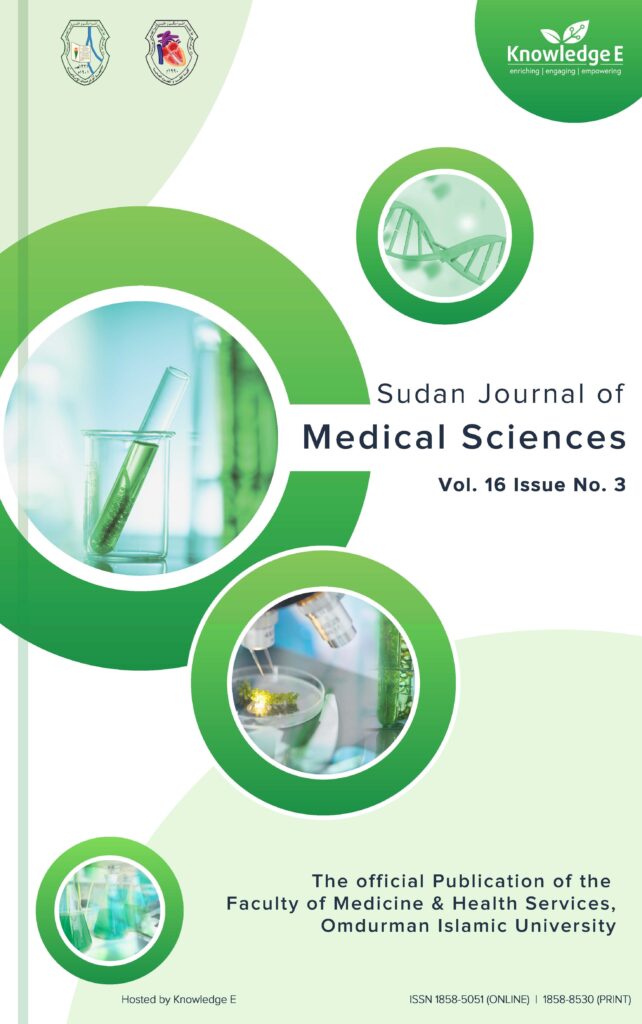
Sudan Journal of Medical Sciences
ISSN: 1858-5051
High-impact research on the latest developments in medicine and healthcare across MENA and Africa
Bilateral Sub-acute Subdural Hematoma of the Posterior Fossa As a Complication of Anti-coagulation Therapy: A Case Report and Literature Review
Published date:Sep 30 2022
Journal Title: Sudan Journal of Medical Sciences
Issue title: Sudan JMS: Volume 17 (2022), Issue No. 3
Pages:416 - 422
Authors:
Abstract:
Background: Subdural hematomas are one of the commonest neurosurgical pathologies faced in practice and it is rarely located in the posterior fossa. Posterior fossa subdural hematomas are challenging because of the difficulty in their diagnosis and management.
Case Presentation: A case of bilateral sub-acute subdural hematoma of the posterior fossa in a 65-year-old female presented with a complaint of headache and vomiting for three weeks followed by a decreased level of consciousness two days prior to admission. The patient is a known cardiac patient on long-term anti-coagulant, her condition was intensively investigated and the diagnosis of posterior fossa subacute hematoma was reached, following which the patient was treated surgically and improved in the postoperative period.
Conclusion: Subdural hematomas located in posterior fossa are considered very rare. Most of the reported cases are due to anti-coagulant use, with minor number of cases due to trauma. Literature denoted difficulty reaching diagnosis using only computed tomography and advice to be aided by magnetic resonance imaging as in our case. In most occasions, surgical management is the best choice for the management of such a case, regardless of surgical technique, and will result in excellent outcome.
Keywords: posterior fossa, sub-acute subdural hematoma, anticoagulation therapy complications
References:
[1] Ashkenazi, E., & Pomeranz, S. (1994). Nystagmus as the presentation of tentorial incisure subdural haematoma. Journal of Neurology, Neurosurgery, and Psychiatry, 57, 830–831. Advance online publication. https://doi.org/10.1136/jnnp.57.7.830
[2] Misra, M., Salazar, J. L., & Bloom, D. M. (1996). Subdural-peritoneal shunt: Treatment for bilateral chronic subdural hematoma. Surgical Neurology, 46, 378–383. Advance online publication. https://doi.org/10.1016/S0090-3019(96)00188-7
[3] Gardner, W. J. (1932). Traumatic subdural hematoma: With particular reference to the latent interval. Archives of Neurology and Psychiatry, 27, 847. Advance online publication. https://doi.org/10.1001/archneurpsyc.1932.02230160088009
[4] Haines, D. E., Harkey, H. L., & Al-Mefty, O. (1993). The “subdural” space: A new look at an outdated concept. Neurosurgery, 32, 111–120. Advance online publication. https://doi.org/10.1227/00006123-199301000-00017
[5] Vaquero, J., Zurita, M., & Cincu, R. (2002). Vascular endothelial growth-permeability factor in granulation tissue of chronic subdural haematomas. Acta Neurochirurgica, 144, 343–346. Advance online publication. https://doi.org/10.1007/s007010200047
[6] Ciembroniewicz, J. E. (1965). Subdural hematoma of the posterior fossa. Review of the literature with addition of three cases. Journal of Neurosurgery, 22, 465–473. Advance online publication. https://doi.org/10.3171/jns.1965.22.5.0465
[7] Stendel, R., Schulte, T., Pietilä, T. A., Suess, O., & Brock, M. (2002). Spontaneous bilateral chronic subdural haematoma of the posterior fossa. Case report and review of the literature. Acta Neurochirurgica, 144, 497–500. Advance online publication. https://doi.org/10.1007/s007010200072
[8] Arseni, C., & Maretsis, M. (1972). Traumatic cerebellar haematoma associated with posterior cerebral fossa subdural haematoma. Psychiatria, Neurologia, Neurochirurgia, 75, 113–115.
[9] Rothballer, A. B. (1962). Traumatic cerebellar hematoma in the newborn. Case report of operative removal with survival. Journal of Neurosurgery, 19, 913–915. Advance online publication. https://doi.org/10.3171/jns.1962.19.10.0913
[10] Silverstein, A. (1979). Neurological complications of anticoagulation therapy: A neurologist’s review. Archives of Internal Medicine, 139, 217–220. Advance online publication. https://doi.org/10.1001/archinte.1979.03630390069025
[11] Gross, S. W. (1955). Posterior fossa hematomas, 22, 286–289.
[12] Capistrant, T., Goldberg, R., Shibasaki, H., & Castle, D. (1971). Posterior fossa subdural haematoma associated with anticoagulant therapy. Journal of Neurology, Neurosurgery, and Psychiatry, 34, 82–85. https://doi.org/10.1136/jnnp.34.1.82
[13] Kanter, R., Kanter, M., Kirsch, W., & Rosenberg, G. (1984). Spontaneous posterior fossa subdural hematoma as a complication of anticoagulation. Neurosurgery, 15, 241–242. https://doi.org/10.1227/00006123-198408000-00015
[14] Lagares, A., Domínguez, J., Lobato, R. D., & González, P. (1998). Bilateral posterior fossa subdural haematomas secondary to anticoagulant therapy. Acta Neurochirurgica, 140, 1097–1098. https://doi.org/10.1007/s007010050222
[15] Zenteno-Alanis, G. H., Corvera, J., & Mateos, J. H. (1968). Subdural hematoma of the posterior fossa as a complication of anticoagulant therapy. Presentation of a case. Neurology, 18, 1133–1136. https://doi.org/10.1212/WNL.18.11.1133
[16] Kurisu, K., Kawabori, M., Niiya, Y., Ohta, Y., Mabuchi, S., Houkin, K. (2012). Bilateral chronic subdural hematomas of the posterior fossae. Neurologia Medico-Chirurgica, 52, 822–825. Advance online publication. https://doi.org/10.2176/nmc.52.822
[17] Takemoto, Y., Matsumoto, J., Ohta, K., Hasegawa, S., Miura, M., & Kuratsu, J. I. (2016). Bilateral posterior fossa chronic subdural hematoma treated with craniectomy: Case report and review of the literature. Surgical Neurology International, 7(10), S255– S258. https://doi.org/http://dx.doi.org/10.4103/2152-7806.181979